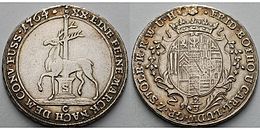Deer guilder
Two different historical coins are known as Hirschgulden , which were used as currency in the 17th century in Württemberg and in the 18th century in Saxony.
The Württemberg Hirschgulden was first used as a literary symbol for an inappropriately low amount in 1823, when Gustav Schwab recorded an oral story by a landlord from Dürrwangen and reproduced it in his travel guide, The Neckar Side of the Swabian Alb, slightly changed. This episode, which Schwab calls the “saga of the three brothers” , came to the attention of the writer Wilhelm Hauff when he bought the Schwab travel guide in 1825. Hauff expanded and changed the "saga of the three brothers" comprehensively and added it under the title The saga of the Hirschgulden as a partial story in his third volume of the "fairy tale almanac for sons and daughters of educated estates" in the frame story of the inn in Spessart ; the volume appeared in 1827 after Hauff's death.
The Württemberg Hirschgulden

The Coat of arms of Württemberg since the late 13th century shows three superimposed Hirsch bars , so the deer appears frequently in various capacities on Württemberg coins; for example, he acts as a sign holder . In the years 1622 and 1623, so-called “Kipper guilders” were minted in Württemberg during the Kipper and Wipper times, which show a lying deer on the reverse of the coin, which lays its right foreleg on a cartouche with the value 60 - for 60 Kreuzer; the coin was named after this deer motif. Half deer gulden were also issued during this time, which are designed exactly like the whole gulden, only that they have the value 30 in the cartouche. Double stag guilders show two stag facing each other, in the middle of which a cartridge with the number 120 is attached.
The Hirschgulden were minted in four different Württemberg mints : Stuttgart coins are marked with the mintmark "S" or have none, coins from Christophstal near Freudenstadt have the mintmark "CT" or "C", Tübingen coins can be recognized by a "T" Coins from Berg show a Moor's head.
These "kipper coins" were produced in large quantities, but were of little value. At the end of the Kipper and Wipper era in 1623, the coins were exchanged for new money, banned and confiscated; therefore, original coins from this period, especially in good condition, are relatively rare.
The Stolbergsche two-thirds thaler

Between 1739 and 1796, two-thirds thalers were minted in Stolberg in the Harz Mountains , some of which consisted of fine silver and were worth one guilder. On the back, they show Stolberg's heraldic animal, a standing deer, in front of a column. There are also so-called half-pieces of these coins, which are worth a third of a thaler.
Individual evidence
- ↑ In detail Dieter Mertens in his essay "Die Schalksburgsage" (PDF; 6.3 MB) from 2005.
- ↑ Lemma Hirschgulden in Numispedia
- ↑ Lemma Hirschgulden in the Münzen-Lexikon ( Memento of the original of November 24, 2007 in the Internet Archive ) Info: The archive link was inserted automatically and has not yet been checked. Please check the original and archive link according to the instructions and then remove this notice.
